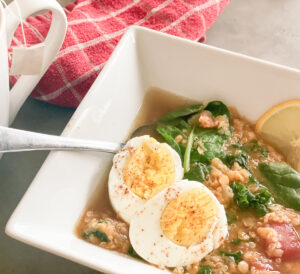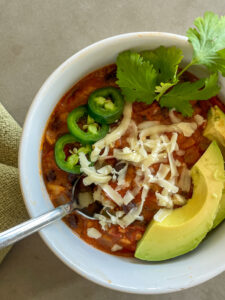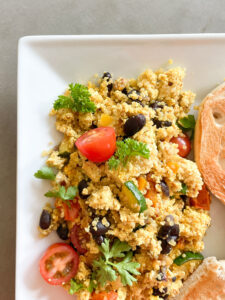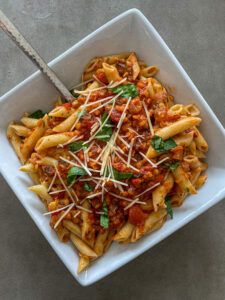Quinoa Protein Content vs Meat | Health Benefits

In my opinion, quinoa is an underrated health food. It is a whole grain, naturally low in pesticides, and a high quality source of protein and fiber. So, when we compare quinoa protein content vs meat, how does quinoa stand up to animal protein? And what are the benefits of adding this high-protein grain to your diet?
A quick answer would be: Quinoa stands out among plant-based protein sources by offering a well-balanced and complete profile of essential amino acids, placing it on par with proteins derived from animals. But, read on to find more specific comparisons between quinoa and meat and to be inspired to add this simple, but powerful, superfood to your routine. Even find 21 unique ways to add quinoa to your diet!
- What is Quinoa?
- Quinoa vs Chicken
- Quinoa vs Beef
- Quinoa vs Pork
- More High Protein Grains
- Is quinoa naturally low in pesticides?
- What grains have more protein than quinoa?
- Quinoa Protein Content vs Meat: Is quinoa a high quality protein?
- Is quinoa a carb or a protein?
- Why should I incorporate quinoa in my diet?
- Quinoa Protein Content vs Meat: Can quinoa replace meat protein?
- Can you get enough protein from quinoa?
- 21 Ways to Add Quinoa to your Diet
- You Might Also Be Interested In:
- Recipes From Each Healthy Bite
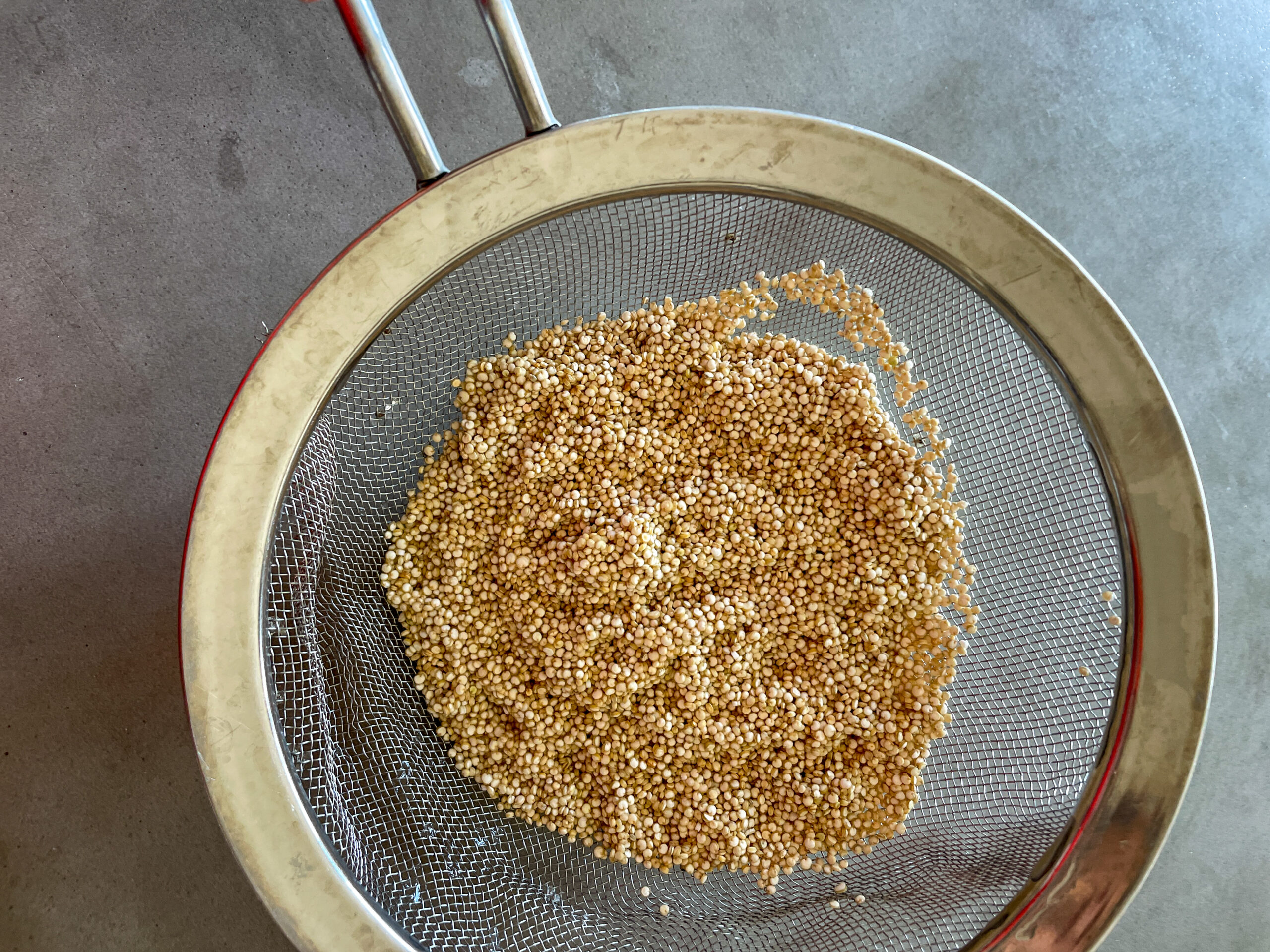
What is Quinoa?
Quinoa is an ancient grain, scientifically known as Chenopodium quinoa Willd, originating from South America. This nutritious pseudocereal has become increasingly popular in recent years due to its high nutritional value and versatility in various dishes. It stands out as a whole grain, providing essential nutrients like dietary fiber, B vitamins (including pantothenic acid), and minerals such as magnesium, phosphorus, manganese, and copper.
Notably, quinoa is naturally gluten-free, making it an excellent option for individuals with gluten sensitivities, gluten intolerance or celiac disease. Its low glycemic index contributes to better blood sugar level regulation, supporting a healthy diet, and potentially reducing the risk of heart disease. Moreover, quinoa's nutty flavor enhances its appeal, making it a delightful addition to various recipes.
In terms of its protein content, quinoa is exceptional, boasting all nine essential amino acids required by the human body. A 100-gram serving of quinoa delivers approximately 14 grams of protein, making it a great choice for those seeking plant-based protein sources. This high protein content makes quinoa suitable for muscle growth, weight loss, and overall energy production within the body.
Quinoa vs Chicken
Here is a comprehensive look at the protein, fat and vitamin content of chicken compared to quinoa.
Quinoa Protein Content vs. Meat (Chicken)
In comparison to chicken, quinoa's protein content is impressive, making it an excellent choice for plant-based diets or those seeking diverse protein alternatives. In a 100-gram serving, quinoa provides approximately 4 grams of protein, while chicken, specifically cooked, skinless, boneless breast, delivers around 31 grams. While chicken offers a higher protein content, considering the overall nutritional profile is key for making informed dietary choices.
Quinoa Fat Content vs Chicken
When it comes to fat content, quinoa takes the spotlight for its low saturated fat levels and healthy unsaturated fats. In contrast, chicken, while a lean protein source, contains higher amounts of saturated fats. Choosing quinoa over certain cuts of chicken can be a heart-healthy decision without compromising on flavor and nutrition.
Quinoa Vitamins and Minerals vs Chicken
Quinoa generally offers a more diverse range of vitamins and minerals compared to chicken. While chicken is a good source of specific nutrients like B vitamins (B3, B6, B12), phosphorus, selenium, zinc, iron, magnesium, and potassium, quinoa provides a broader spectrum of micronutrients, including significant amounts of iron, magnesium, phosphorus, manganese, and copper, along with B vitamins (B1, B2, B3, B6, folate) and vitamin E.
Quinoa vs Beef
Now let's take a look at the nutritional value of quinoa compared to beef.
Quinoa Protein Content vs. Meat (Beef)
In a 100-gram serving, lean ground beef typically provides around 26 grams of protein, making it a substantial source of this nutrient. In contrast, cooked quinoa offers approximately 4 grams of protein per 100 grams. While beef provides a higher protein content, quinoa is valued for being a plant-based complete protein with a unique nutritional profile.
Quinoa Fat Content vs Beef
In a 100-gram serving, lean ground beef typically contains around 10 grams of fat, representing a higher fat content compared to quinoa. Cooked quinoa, on the other hand, has approximately 1.9 grams of fat per 100 grams. Choosing between the two may depend on dietary preferences, nutritional needs, and the desired fat content in a meal.
Quinoa Vitamins and Minerals vs Beef
Lean ground beef is a robust source of B vitamins, particularly B12 and niacin, along with essential minerals such as iron, zinc, and phosphorus. These nutrients play crucial roles in supporting energy metabolism, immune function, and red blood cell formation.
On the other hand, quinoa, a plant-based option, offers significant amounts of iron, magnesium, phosphorus, manganese, copper, and various B vitamins (B1, B2, B3, B6, and folate), contributing to overall well-being and metabolic processes.
Quinoa vs Pork
Finally, let's take a look at the nutritional value of quinoa vs pork, one of the most popular animal proteins.
Quinoa Protein Content vs Meat (Pork)
In a 100-gram serving, cooked pork chops provide approximately 25 grams of protein, presenting a substantial protein content. On the other hand, cooked quinoa offers around 4 grams of protein per 100 grams. The choice between pork and quinoa may hinge on individual dietary preferences and nutritional goals, given the considerable difference in their protein content.
Quinoa Fat Content vs Pork
In a 100-gram serving, cooked pork chops have approximately 15 grams of fat, representing a higher fat content compared to quinoa. Cooked quinoa, by contrast, contains approximately 1.9 grams of fat per 100 grams. Choosing between pork and quinoa may depend on dietary preferences and nutritional goals, considering the considerable difference in their fat content.
Quinoa Vitamins and Minerals vs Pork
In cooked pork chops, essential nutrients include B vitamins (B6, B12, niacin), iron, zinc, phosphorus, and selenium, contributing to energy metabolism, immune function, and overall well-being.
Conversely, cooked quinoa serves as a plant-based powerhouse, providing significant amounts of iron, magnesium, phosphorus, manganese, copper, and various B vitamins (B1, B2, B3, B6, folate). These nutrients support bone health, energy production, and metabolic processes.
Choosing between pork and quinoa involves considering individual dietary preferences and health objectives, as both contribute valuable vitamins and minerals to a balanced diet.
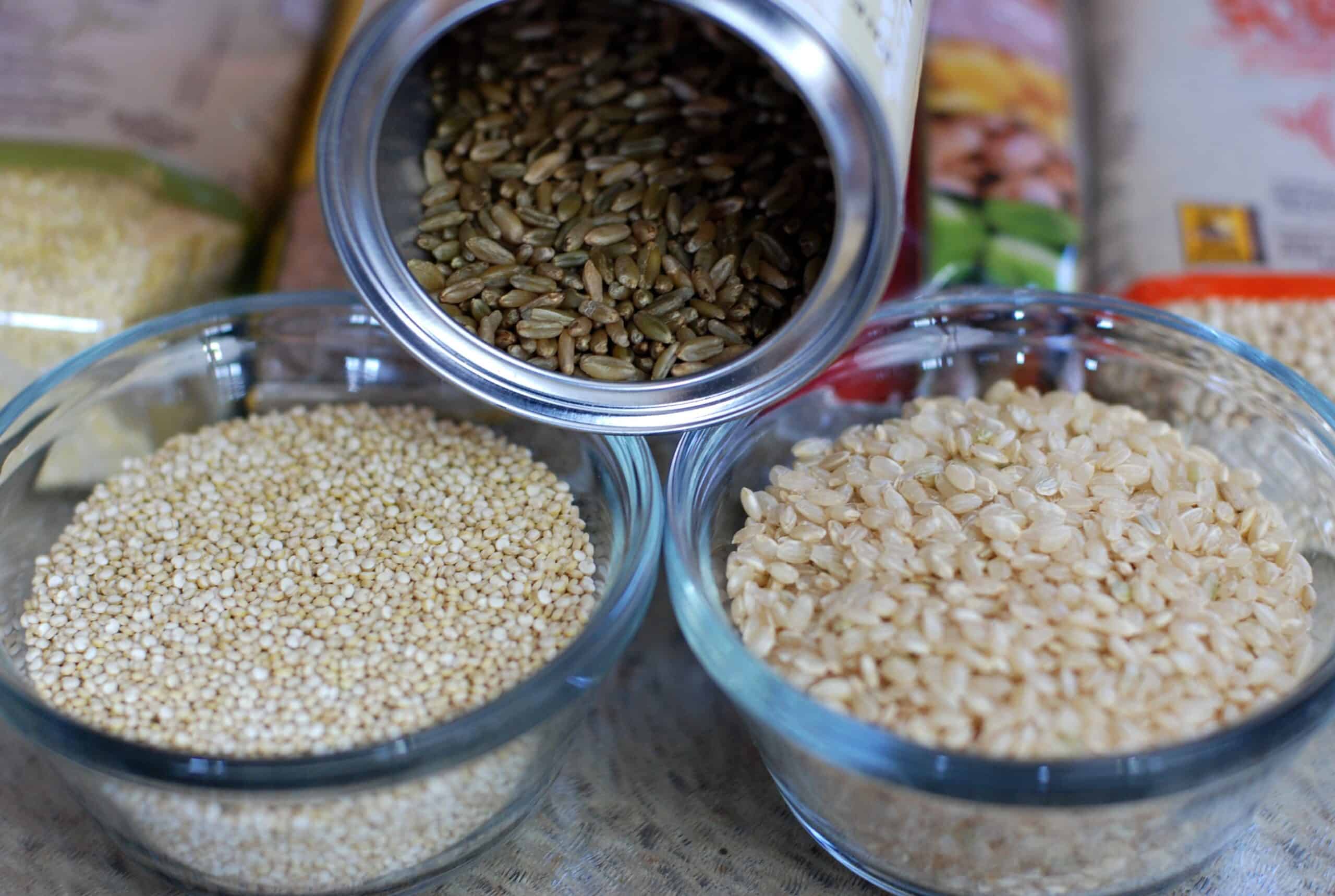
More High Protein Grains
Here is a list of 8 other grains that are high in protein like quinoa:
- Amaranth: A gluten-free grain rich in protein, amaranth can be cooked like rice or added to soups and stews.
- Buckwheat: Despite its name, buckwheat is not related to wheat and is gluten-free. It's high in protein and can be used in porridge, pancakes, and as a substitute for rice.
- Quinoa: As mentioned, quinoa is a complete protein, containing all essential amino acids. It's versatile and can be used in a variety of dishes.
- Farro: This ancient grain is rich in protein and fiber. It has a nutty flavor and can be used in salads, soups, or as a side dish.
- Freekeh: Made from roasted green wheat, freekeh is a protein-rich grain that can be used in pilafs, salads, or soups.
- Millet: A gluten-free grain that is high in protein and can be used in both sweet and savory dishes.
- Wild Rice: Unlike white rice, wild rice is a good source of protein and can be used in salads, casseroles, or as a side dish.
- Spelt: An ancient grain related to wheat, spelt is higher in protein and can be used in baking or as a substitute for rice.
Incorporating a variety of these protein-rich grains into your meals ensures a diverse and well-balanced intake of nutrients.
Is quinoa naturally low in pesticides?
Quinoa is naturally low in pesticides due to its hardy plant characteristics, including natural resistance to pests and diseases attributed to bitter compounds called saponins. Quinoa has adapted to thrive in diverse conditions with minimal reliance on synthetic pesticides. Traditional and sustainable agricultural practices, including crop rotation and organic farming, further contribute to quinoa's lower pesticide content.
What grains have more protein than quinoa?
Here is a list of five grains that have a higher protein content per 100 grams than quinoa:
- Teff: About 13 grams of protein per 100 grams.
- Amaranth: Approximately 14 grams of protein per 100 grams.
- Buckwheat: Roughly 13 grams of protein per 100 grams.
- Lupin (flour): Contains a substantial amount, often exceeding 30 grams of protein per 100 grams, but this can vary based on the specific lupin product.
- Kamut: Provides around 15 grams of protein per 100 grams.
Quinoa Protein Content vs Meat: Is quinoa a high quality protein?
Quinoa is considered a high-quality protein because it is a complete protein. A complete protein contains all nine essential amino acids that the human body cannot produce on its own.
Quinoa is unique among plant-based protein sources in that it provides a balanced and sufficient amount of all essential amino acids, making it comparable to animal-based proteins.
This quality makes quinoa an excellent protein source for vegetarians, vegans, and individuals looking to diversify their protein intake.
Is quinoa a carb or a protein?
Quinoa is both a carbohydrate and a protein, but it is often classified as a pseudocereal due to its unique nutritional composition. Here's a breakdown:
- Carbohydrates: The majority of the calories in quinoa come from carbohydrates. It is a good source of complex carbohydrates, providing energy in the form of starch. This makes quinoa a valuable component of a balanced diet, particularly for those seeking a healthy source of carbohydrates.
- Protein: Quinoa is also notable for its protein content, and it is considered a complete protein. It contains all nine essential amino acids that the body cannot produce on its own. This makes quinoa a valuable protein source, especially for individuals following vegetarian or vegan diets.
Why should I incorporate quinoa in my diet?
Incorporating quinoa into your diet offers a multitude of health benefits, making it a valuable addition to your meals. One standout feature is its role as a complete protein source, containing all essential amino acids, making it an excellent choice for vegetarians, vegans, or those aiming to diversify their protein intake. Beyond its protein content, quinoa is rich in essential nutrients such as iron, magnesium, phosphorus, manganese, and various B vitamins, contributing to overall health and well-being.
Moreover, quinoa boasts antioxidant properties that help protect the body from oxidative stress and inflammation. This, coupled with its fiber content, supports heart health by aiding in cholesterol management, blood pressure regulation, and overall cardiovascular function.
Quinoa Protein Content vs Meat: Can quinoa replace meat protein?
Quinoa serves as an excellent substitute for meat protein, particularly for those following vegetarian or vegan diets or seeking meat alternatives. Its standout feature is its status as a complete protein, providing all essential amino acids crucial for bodily functions and muscle health. This makes quinoa nutritionally comparable to meat, offering a valuable plant-based alternative with a protein quality that stands out among other grains.
Beyond its protein content, quinoa is a nutrient-rich grain, offering essential minerals such as iron, magnesium, phosphorus, manganese, and various B vitamins. This diverse nutritional profile contributes not only to meeting protein needs but also to overall well-being. Its versatility in cooking further enhances its role as a meat substitute, fitting into a variety of dishes.
Can you get enough protein from quinoa?
Absolutely, getting enough protein from quinoa is not only feasible but also highly beneficial, especially for those embracing vegetarian or vegan lifestyles. Quinoa stands out as a complete protein, containing all essential amino acids vital for bodily functions. A standard serving of cooked quinoa, approximately 1 cup, provides around 8 grams of protein, making it a significant contributor to your daily protein needs.
To maximize protein intake from quinoa, it's advisable to consider serving sizes based on individual dietary requirements. Additionally, diversifying your protein sources by incorporating other plant-based options like legumes, beans, lentils, tofu, and nuts ensures a more comprehensive range of essential nutrients and amino acids.
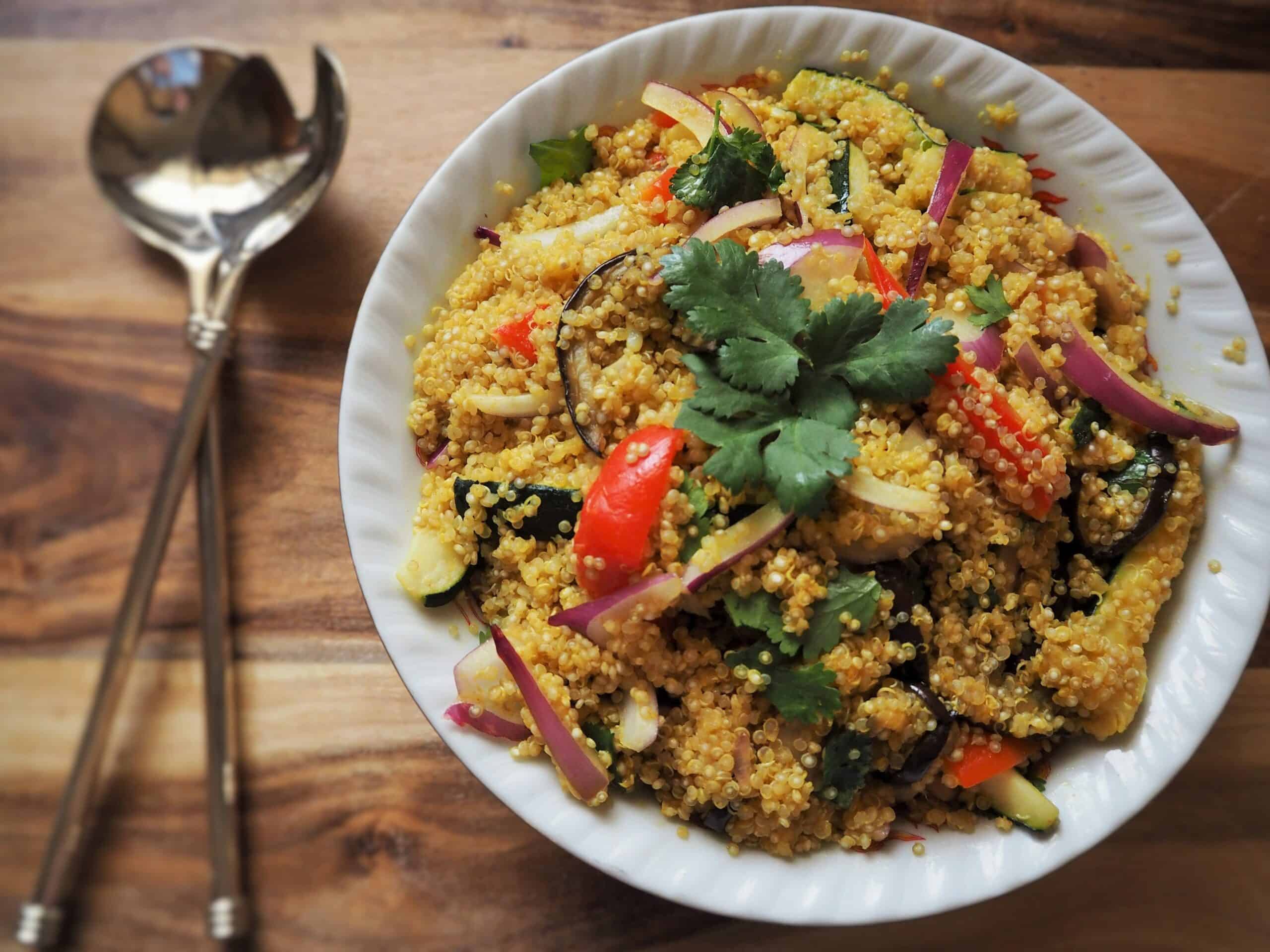
21 Ways to Add Quinoa to your Diet
Here are 21 creative ways to incorporate quinoa into your diet:
- Quinoa Salad: Mix cooked quinoa with your favorite vegetables, herbs, and a light vinaigrette for a refreshing salad.
- Quinoa Vegan Breakfast Scramble: Try this vegetable, quinoa, tofu breakfast scramble!
- Quinoa Breakfast Bowl: Top cooked quinoa with fruits, nuts, seeds, and a drizzle of honey or yogurt for a nutritious breakfast.
- Quinoa Stuffed Peppers: Use quinoa as a filling for stuffed peppers along with vegetables, beans, and cheese.
- Quinoa Stir-Fry: Add cooked quinoa to your favorite stir-fry recipe for an extra boost of protein and texture.
- Quinoa and Vegetable Soup: Incorporate quinoa into your favorite vegetable soup for added heartiness and nutrition. Try this Lentil and Quinoa Broth Bowl!
- Quinoa Burger Patties: Mix quinoa with black beans, spices, and breadcrumbs to make delicious veggie burger patties.
- Quinoa Sushi Rolls: Use quinoa instead of rice in sushi rolls for a unique and nutritious twist.
- Quinoa Breakfast Bars: Make homemade granola or breakfast bars using quinoa, nuts, seeds, and dried fruits.
- Quinoa Tacos: Replace traditional taco filling with seasoned quinoa for a tasty and protein-packed alternative.
- Quinoa Pudding: Create a dessert by cooking quinoa with milk, sweetener, and your favorite flavorings to make a quinoa pudding.
- Quinoa Pizza Crust: Mix quinoa with eggs and herbs to make a gluten-free pizza crust.
- Quinoa and Roasted Vegetable Bowl: Roast your favorite vegetables and toss them with cooked quinoa for a wholesome bowl.
- Quinoa Tabouleh: Prepare a refreshing tabouleh salad using quinoa instead of bulgur.
- Quinoa Breakfast Muffins: Bake quinoa into muffins with eggs, vegetables, and cheese for a portable breakfast option.
- Quinoa and Black Bean Burritos: Fill tortillas with a mixture of quinoa, black beans, salsa, and cheese for a satisfying burrito.
- Quinoa Pesto Pasta: Toss cooked quinoa with your favorite pesto sauce and vegetables for a quick and flavorful pasta alternative.
- Quinoa Energy Bites: Combine quinoa with nut butter, honey, and add-ins like chocolate chips to make energy-packed bite-sized snacks.
- Quinoa Fritters: Mix quinoa with grated vegetables, herbs, and breadcrumbs to form fritters that can be baked or pan-fried.
- Quinoa Buddha Bowl: Build a nourishing Buddha bowl with quinoa as the base, topped with a variety of colorful vegetables, proteins, and sauces.
- Quinoa Smoothie Bowl: Blend quinoa into a smoothie bowl with your favorite fruits, yogurt, and toppings for a nutritious breakfast or snack.
You Might Also Be Interested In:
Recipes From Each Healthy Bite
